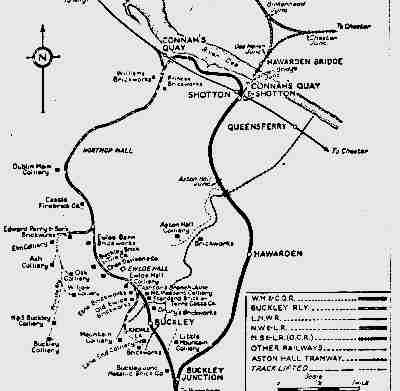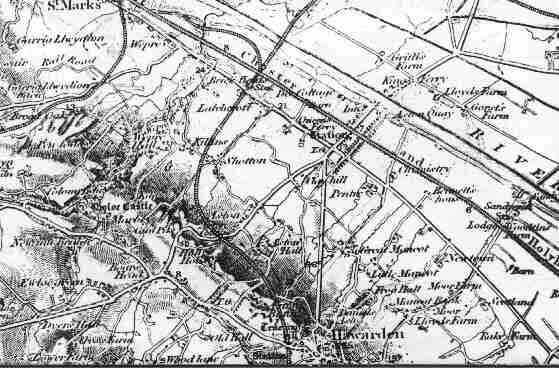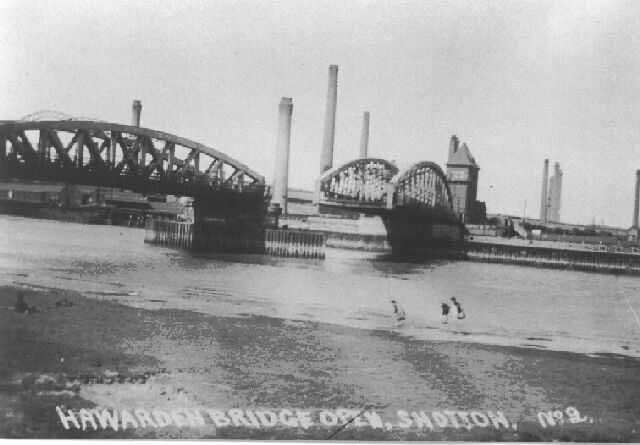
![]()
10. The Railway & The Hawarden Bridge
![]()
The mid-nineteenth century saw a great increase in rail traffic in the district and better connections were needed from Shotton to Chester and the North of England for the transportation of coal. The great salt works of Cheshire required a million tons of powdered coal, known as "slack" annually, and enormous quantities were being wasted in the North Wales coalfields due to the lack of a rail connection. In addition to coal, North Wales produced thousands of tons of bricks, tiles and drainage pipes. Limestone, lead mines and other minerals were also awaiting exploitation. The River Dee Channel, which a hundred years earlier had brought industry to the town, now appeared to be hindering its further development. How could a railway be built when a busy shipping river lay in the way?
![]()
Since 1861 nine
proposals had been made to parliament to connect the railways of North Wales to
the Mersey Docks. In 1866 Sir James Allport, on behalf of the Midland Railway
Company; Mr. Seymour Clarke, the general manager of the Great Northern Railway;
and Mr. R. G. Underdown, representing the Manchester, Sheffi eld and
Lincolnshire Railway, proposed the building of a railway tunnel beneath the
River Dee. Due to the fact that it would not have been possible to link this to
the docks at Connah's Quay, the project was dismissed as impracticable. In
1876, the Birkenhead, Chester and North Wales Bill sought, and gained,
Parliament's approval of a high-level bridge across the Dee. Once again,
though, the project failed. Nothing as large as this had been built in Britain
and it was difficult to convince investors that the project could succeed. It
was at this point that Henry Robertson and Benjamin Piercy of the Wrexham, Mold
and Connah's Quay Railway Company approached the Chairman of the Manchester,
Sheffield and Lincolnshire Railway Company, Sir Edward Watkin, Bart., M.P., to
discuss the need for a bridge. Watkin was a powerful and influential railway
magnate at that time, and the W,M & CQ Rail Co. hoped to induce him to
promote an Act of Parliament for a railway to be built from Chester, Northgate,
crossing a bridge over the Dee, and connecting to the W,M & CQ lines from
Buckley.
eld and
Lincolnshire Railway, proposed the building of a railway tunnel beneath the
River Dee. Due to the fact that it would not have been possible to link this to
the docks at Connah's Quay, the project was dismissed as impracticable. In
1876, the Birkenhead, Chester and North Wales Bill sought, and gained,
Parliament's approval of a high-level bridge across the Dee. Once again,
though, the project failed. Nothing as large as this had been built in Britain
and it was difficult to convince investors that the project could succeed. It
was at this point that Henry Robertson and Benjamin Piercy of the Wrexham, Mold
and Connah's Quay Railway Company approached the Chairman of the Manchester,
Sheffield and Lincolnshire Railway Company, Sir Edward Watkin, Bart., M.P., to
discuss the need for a bridge. Watkin was a powerful and influential railway
magnate at that time, and the W,M & CQ Rail Co. hoped to induce him to
promote an Act of Parliament for a railway to be built from Chester, Northgate,
crossing a bridge over the Dee, and connecting to the W,M & CQ lines from
Buckley.
Map showing the new line from Buckley Junction to Shotton
The effort was successful, for on 29th June 1883 an Act of Parliament provided for the W,M & CQ Railway to build a double line track from Buckley Junction to Shotton. On 28th July 1894 another Act provided for the construction of a Dee Bridge by the M,S & L Railway Co.
![]()

Map of 1894 showing the railways in the area
![]()
On Tuesday, the 16th August 1887, William Ewart Gladstone, (the four-times British Prime Minister), and his wife Catherine, of Hawarden Castle, were on the banks of the Dee. The occasion was the laying in the river of the first and main cylinder of the Dee Railway Bridge.
A large crowd had gathered on the river banks and there were 500 V.I.Ps present. Sir Edward Watkin presented Mr. Gladstone with an inscribed gold whistle. William Gladstone was given an ebony staff upon which was mounted a silk flag printed with an Heraldic insignia. To signal the start of the proceedings, Mrs. Gladstone blew on her whistle and Mr. Gladstone waved his flag. The crowd cheered as the cylinder was lowered slowly into its exact position. Speeches were given, then lunch was served to the V.I.Ps in a number of tents.
The Buckley to Shotton branch line was already under construction, and its course was set to cut through the middle of Shotton's farmlands. In 1889 a wooden bridge was constructed off Charmley's Lane, crossing the course of the new railway. It became known as the "Cattle Bridge" as it was used to move carts and cattle between the fields each side of the track. The wooden bridge burned down in 1906 and was replaced by a stone walled bridge on steel girders. The low stone walls were replaced in recent years by wire mesh and steel panels, which can now be heard "whistling" on windy days.
On Saturday, the 3rd August 1889, the day which had been set aside for the celebration of Mr. and Mrs. Gladstone's Golden Wedding Anniversary, another huge crowd had gathered on both sides of the Dee to witness the opening of the Dee Railway Bridge.
Mr. and Mrs. Gladstone and party left London's Kings Cross station at 9:35a.m. The specially chartered train called first at Grantham, then at Sheffield and was intended to call at Manchester to complete a symbolic journey in recognition of the M. S. & L. Railway. The train was running late, however, and it was diverted to a junction near Altrincham where extra coaches were added, carrying the directors and officials of the M. S. & L. Company.
The train reached the Dee Bridge at 3:37p.m., just 20 minutes later than scheduled, and crossed the swinging span of the bridge from the Cheshire side. It came to a standstill opposite a specially prepared platform, covered with crimson cloth, on a fixed section of the bridge.
As Mr. and Mrs. Gladstone alighted, the Band of the 1st Volunteer Battalion of the Royal Welsh Fusiliers played "March of the Men of Harlech." The train backed across the bridge to the Cheshire side, and the proceedings commenced with Mr. Cochrane, one of the contractors, presenting Mrs. Gladstone with a magnificent bouquet. When the bouquet was removed from its resting position it revealed the button of an electric bell. Sir Edward Watkin then presented Mrs. Gladstone with a small gold casket bearing the inscription:
"Presented to Mrs. Gladstone on her naming of the great bridge over the Dee connecting Wales with England."
The large crowd let out a tremendous cheer when Catherine Gladstone pressed the electric button which set the swinging span of the bridge in motion. The 752 ton 287 foot span, the largest, (by 36 feet), of its kind in Britain at the time, rotated through 90 degrees in 40 seconds. When the bridge had been closed again, Mrs. Gladstone said:
"I have the greatest pleasure in declaring the bridge open and calling it by the name of the Hawarden Bridge."
A large flotilla, including the tug called "Albert" then passed the bridge to further cheers from the crowd. Sir William Gladstone then stepped forward to address the assemblage on the platform.
Click Here to see the speech in full.
The V.I.P.s then entered a marquee, erected on the fixed portion of the bridge, and light refreshments were served. Following speeches and toasts, Mr. and Mrs. Gladstone descended from the bridge and entered a horse-drawn carriage which was waiting nearby. Unfortunately the Buckley to Shotton railway line had not been completed in time for the opening ceremony of the bridge, so the Gladstones had to return to Hawarden by road, where another large crowd had gathered for the wedding anniversary celebrations.
The bridge was one of the most remarkable engineering feats of its time and was designed by Mr. C. A. Hobson. The contractors were Messrs. John Cochrane & Sons of Westminster, and the steel structure and machinery construction was subcontracted to Horsley Bridge Company of Tipton, Staffordshire. The Chief-Engineer for the entire project was Mr. Frances Fox, and the total cost of the bridge was £71,000.
The swinging span allowed the river to continue to be navigable by ships to Chester, and in its early days of operation it was necessary to open it about eleven times a week.
![]()

Hawarden bridge opening for shipping in 1910
![]()
The wooden platform at Shotton's low-level station was intended to be a temporary structure until a through-running junction had been built with the Chester to Holyhead line. However, poor business relations with the L.N.W.R., the owners of the Holyhead line, led to the abandonment of the project, and the station became permanent in order to provide an interchange for the two lines.
![]()

Engineering Drawings of Hawarden Bridge
![]()
As the years passed, fewer ships ventured up the river to Chester, and towards the end of its operating life the Hawarden Bridge would be opened on Sunday mornings to check the mechanisms and perform routine maintenance. The operating mechanism was finally dismantled in the 1960s, and since then the bridge has been a fixed span.
![]()
Weight of the Swing Span and Moving Parts
| Item | Tons | lbs |
| Main girders, cross girders, rail & floor bearers, wind brackets & footway bracket webs | 442 | 1077 |
| Floor plates, bars and angles, rail guard angles Wrought-iron | 46 | 676 |
| Tees and angles in footway brackets wrought-iron | 8 | 1630 |
| Outside footway brackets and standards | 3 | 1120 |
| Hand-rails, tubes and fastenings | 1 | 775 |
| Rails, fish-plates, fastenings, chairs, way beams, guard timbers | 49 | 896 |
| Balance weight | 105 | 0 |
| Bearing Girder | 37 | 115 |
| Chain sheave, 32 feet diameter | 7 | 756 |
| Steel crosshead | 5 | 1512 |
| Steel suspension bolts and nuts | 3 | 616 |
| Cast iron washers and caps for suspension bolts | 3 | 280 |
| Steel chains | 3 | 952 |
| Pivot ball | 1456 | |
| Steel rollers at pivot | 4 | 700 |
| Wrought-iron carriages for steel rollers | 3 | 2184 |
| Cast-iron knuckle plates and saddles | 1 | 952 |
| Wrought-iron ring with radial axles | 1820 | |
| Tail rollers and conplete winch gear | 3 | 1288 |
| Balance weight, preponderance only | 8 | 1792 |
| Cast iron bed plates at tail-end | 1 | 448 |
| Locking gear at tail-end | 1 | 1120 |
| Rams and sheave, approx . | 10 | 0 |
| TOTAL WEIGHT OF MOVING PARTS | 752 | 2006 |
![]()
Copyright © Keith Atkinson 1998 - 2006
You may print out the pages of this website for your own personal use. I do not sell this material in any printed format and therefore if you are offered this for sale, please contact me at shotton@postmaster.co.uk
![]()
Quick Navigation
Home 1 2 3 4 5 6 7 8 9 10 11 12 13 14 15 16 17 18 19 20 21 22